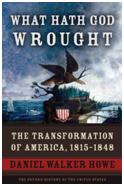 I’m reading a fascinating new book on American History (What Hath God Wrought: The Transformation of America, 1815-1848 – it won the Pulitzer Prize this year) when I ran across this striking passage in chapter 5, titled “Awakenings of Religion:”
I’m reading a fascinating new book on American History (What Hath God Wrought: The Transformation of America, 1815-1848 – it won the Pulitzer Prize this year) when I ran across this striking passage in chapter 5, titled “Awakenings of Religion:”
“Americans eventually came to think of the separation of church and state as one of the achievements of the Revolution, and as guaranteed by the Bill of Rights. Actually, these common beliefs are but half-truths. The Revolution separated church and state in those places where the Church of England had been established in colonial times. But in several New England states, Congregationalist religious establishments, remained in place. Unlike the Anglican establishments, those of the Congregationalists had been on the winning side of the Revolution and did not seem discredited by American independence. The Bill of Rights, added to the national Constitution in 1791, read: “Congress shall make no law respecting an establishment of religion or prohibiting the free exercise thereof.” Applying specifically to Congress, this First Amendment restricted the federal government only, not the states. The Congregational standing orders (as these establishments were called) persisted in Vermont, Connecticut, New Hampshire, and Massachusetts.”
[. . .]
“Under Republican leadership, New Hampshire separated church from state in 1817, and Connecticut in 1818, leaving Massachusetts the only state with an establishment of religion, which would endure until 1833.”
Several points are worth emphasizing.
ONE: The “Establishment Clause” did not require the banishment of religion from the public or civic life of either state or federal government. It prohibited Congress from picking one particular denomination and making it the “national religion.” The Founding Fathers wanted no American counterpart to the Church of England and the Test Act (which required that all public office holders, including all members of Parliament be members of the Church of England). There would be no “Church of the United States.”
TWO: The last US state to have an officially “established” state religion? Class? Anyone? Bueller? Yes, that’s right, MASSACHUSETTS. [heh]
THREE: The phrase “separation of church and state” does not, of course, appear in the US Constitution or the Bill of Rights. It is a phrase taken from a letter written by Thomas Jefferson to the Baptists in Virginia where he expresses his personal opposition to the continuation of the Church of England (aka the Episcopal Church) as the “established” church of the Commonwealth of Virginia.
And again, to sum up, the 1st Amendment guarantees Freedom OF Religion… NOT Freedom FROM Religion. Here’s the full text, which I recommend all students should memorize:
Congress shall make no law respecting an establishment of religion,
or prohibiting the free exercise thereof;
or abridging the freedom of speech, or of the press;
or the right of the people peaceably to assemble, and to petition the Government for a redress of grievances.
/blockquote>
- Rob Shearer
Director, Schaeffer Study Center
<
 I’m reading a fascinating new book on American History (What Hath God Wrought: The Transformation of America, 1815-1848 – it won the Pulitzer Prize this year) when I ran across this striking passage in chapter 5, titled “Awakenings of Religion:”
I’m reading a fascinating new book on American History (What Hath God Wrought: The Transformation of America, 1815-1848 – it won the Pulitzer Prize this year) when I ran across this striking passage in chapter 5, titled “Awakenings of Religion:”